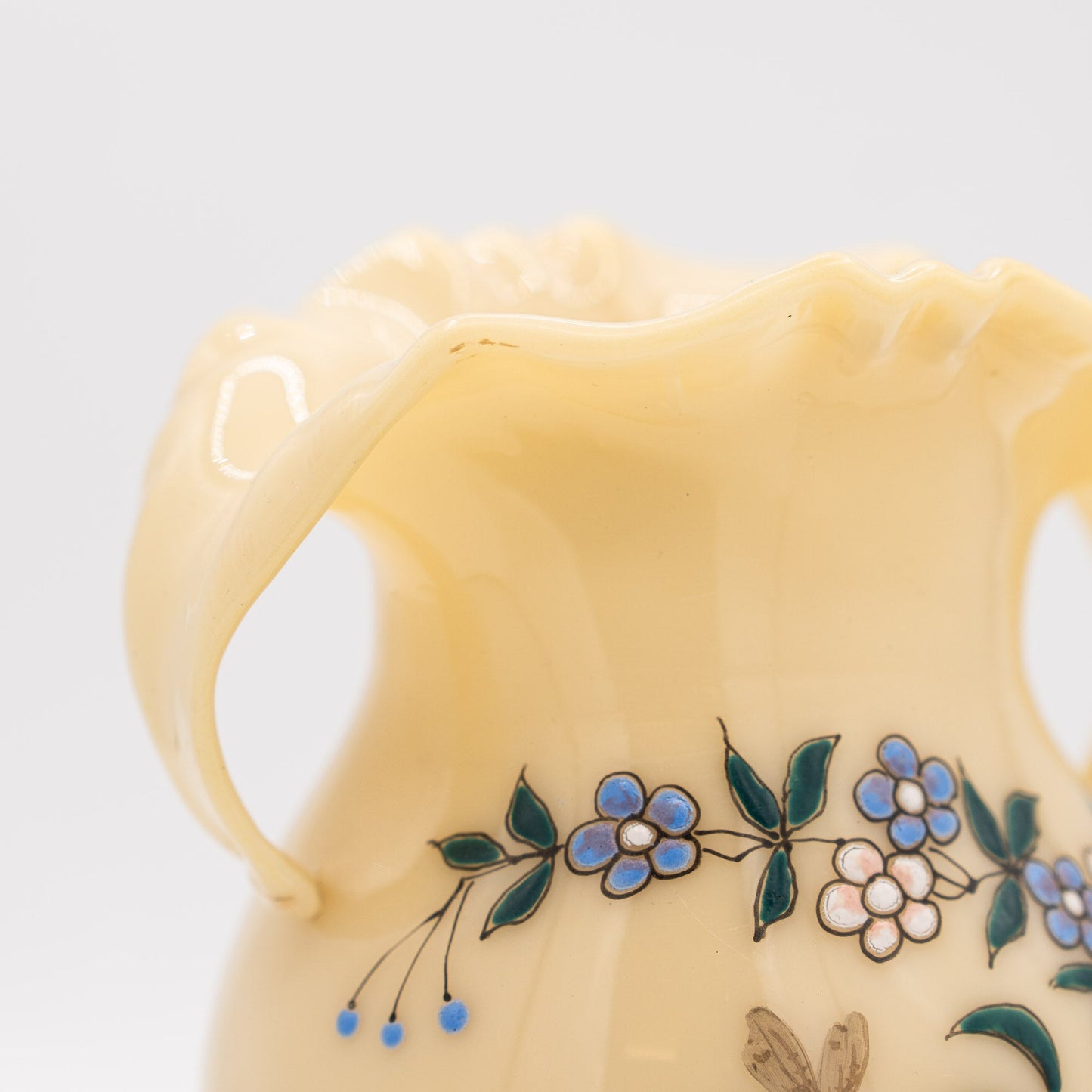The Vintage Tales
French Opaline Two-Handled Vase - Jaune Jonquille - 1890s
French Opaline Two-Handled Vase - Jaune Jonquille - 1890s
Couldn't load pickup availability
A joyful splash of Belle-Époque charm: this French opaline vase in warm jaune jonquille (buttery primrose yellow) is hand-enamelled with sprays of blossom, tiny blue berries and a sweet little bee. With its rippled, frilled mouth and elegant twin handles, it’s a bright, poetic accent for any room.
Opaline glass captured the romantic light of the late 19th century, and this vase shows exactly why collectors love it. The body is blown in a softly opaque primrose tone, then outlined and filled with enamel in deep green, forget-me-not blue, pearly white, and poppy red. A delicate bee hovers amongst the flowers, adding a whimsical note.
The amphora form - twin loop handles, waisted neck, and a flared, frilled rim - sits on a rounded foot. The decoration, with its fine black outlining and dot work, is typical of French pieces from the 1880s–1900 period, often associated with Saint-Denis and Vosges glassworks (e.g., Legras, Portieux/Vallerysthal). Unmarked, as many workshop pieces of the era were, but unmistakably French and full of character.
A lovely size for a small bouquet, or simply to glow on a mantel.
- Material: Opaline glass (jaune jonquille), hand-enamelled decoration
- Maker: Unmarked; French workshop attribution (in the manner of Legras or Portieux/Vallerysthal)
- Motif: Trailing blossoms, forget-me-nots, leaves, and a bee in polychrome enamel with fine black outline
- Style: Belle-Époque / Japonisme-influenced late 19th-century decorative glass
- Place of Origin: France
- Mark: None (typical for the period)
- Date of Manufacture: c.1885–1905
-
Condition: Very good antique condition with gentle age wear. Enamel bright with only minor, expected rubs in places; a few tiny scuffs and specks to the surface; light wear at the foot ring; minuscule nibble to the rim edge noted under magnification only. No cracks or repairs.
Share
- Worldwide Shipping
- Secure Packaging
- Loving Curation










Origin & Maker
Rich in tradition and steeped in history, Vallerysthal is synonymous with exceptional glassmaking.
Its story began in 1707 when Duke Léopold of Lorraine authorised a glassworks at Plaine de Walsch, near the area now known as Vallérysthal. By the early 19th century, the region’s glass was celebrated for its quality, with innovations like the half-crystal and double-coloured, cut glass perfected under M. de Fontenay in 1833. In 1830, the glassworks relocated to Val de Valléry, taking its name from Baron Valléry, and evolved into the renowned Verrerie de Vallérysthal.
The 1872 merger with Verreries de Portieux further enriched the tradition, blending the skills of master glassmakers. Today, with over three centuries of heritage, the glassworks of Vallérysthal and Portieux continue to enchant collectors, combining ancestral craftsmanship with modern techniques.
Blog posts
View all-

A Serendipitous Morning at the Rue de Bretagne ...
There are few joys in life that match the thrill of stumbling upon a hidden treasure, and for me, flea markets hold that magical allure. One of my favourite flea...
A Serendipitous Morning at the Rue de Bretagne ...
There are few joys in life that match the thrill of stumbling upon a hidden treasure, and for me, flea markets hold that magical allure. One of my favourite flea...
-

Emile Bourgeois and "Le Grand Dépôt" in Paris
Recently, I found this stunning Sarreguemines wash set. It was at the Brocante in Belfort, France. On this day, we had got up at 4 AM to be there in...
Emile Bourgeois and "Le Grand Dépôt" in Paris
Recently, I found this stunning Sarreguemines wash set. It was at the Brocante in Belfort, France. On this day, we had got up at 4 AM to be there in...
-

The Legacy of Robert Haviland: A Journey from N...
The story of Robert Haviland porcelain is one of artistry, transatlantic ambition, and enduring heritage. It begins in the mid-19th century when David Haviland, an enterprising New Yorker, founded Haviland...
The Legacy of Robert Haviland: A Journey from N...
The story of Robert Haviland porcelain is one of artistry, transatlantic ambition, and enduring heritage. It begins in the mid-19th century when David Haviland, an enterprising New Yorker, founded Haviland...













